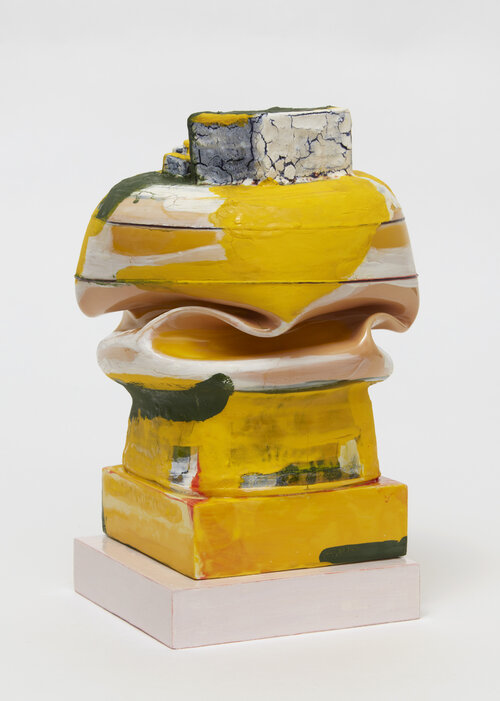
Pink Summit, 2020 © Kathy Butterly, Shoshana Wayne Gallery (Yellow Haze)
Plainly and simply, it’s hard to forget the first time that one sees a Butterly sculpture. It is an intense visual experience, so much so that other senses are roused in envy. Her use of vibrance; startling shades of pink, like coveted sweets, makes you almost feel as though you can, or at least would like to taste her work— clam-like, warped and ajar orifices with impossible seams, folds and symmetries momentarily trick you into believing that if close enough, you might hear one breathe or speak. Surreal isn’t appropriate enough a word for Butterly’s sculptures— minute, ornate, gaudy and brushed with an intense energy. Her work conjures an admiration, a connection and fascination like few other visual artists, because— well, her work is unlike that of most other visual artists. At times work is frustratingly familiar, whilst full of a vibrant, seductive cosmic otherness that’s bold, bizarre, perhaps even perverse at times, and yet painfully beautiful. It’s deformed, impractical and yet wholly perfect. It’s not hard to imagine her works in a Vermillion Sands story (by J.G. Ballard)— ornaments in the fantastical living room of an alien socialite from some utopian, undisclosed future alongside other technologies beyond this aeon. Ultimately, Butterly’s creative practice and output gives way to a certain type of genius that ensnares not only with aesthetic but also with technical ability— imaginatively boundless and unbridled in its capability to embrace nonsense and fun along the way. Within the fashionably rigid and cultic confines of creative conformity, artistic literalism and toxic politicisation within the art world at large, Butterly’s practice is a blissful oasis.
Having worked with clay for nearly thirty years, Butterly’s style has remained largely consistent, citing inspiration from the likes of the proclaimed Mad potter of Biloxi George Ohr (whose scale of influence appears unmatched) amongst others such as Mondrian, Viola Frey, Ron Nagle and many others in good company. Personally, the real beauty, originality and power in her works surrounds its commitment to experimentation, improvisation and to an extent, failure. Though many of her sculptures take on shapes and forms that brush with the familiar, they sag and they slump— they give the convincing illusion that their chief material and multiple kiln-firing has failed them. They parody, examine and analyse in their own ways, repetitively, yet with unique takes each time. Some, with their handles and vague ergonomics, scream out for purpose and functional use, whilst moulded and carved as far away from such a destiny, as possible. It’s almost as though she takes blueprints; forms from the known world— precious geodes buried deep within the earth, lightless creatures from uncharted seas, everyday items such as vases, foodstuffs and body parts, only to one by one subject them to some atom scrambling device that rearranges their forms, reinventing their physical nature with an unbiased, unplanned unpredictability. Her work is a painter’s ambition, a perfectionist’s nightmare and an psychoanalyst’s wet dream— look closely enough and you will see enough glimpses of human orifices, objects of aspirational desire (designer wallets and handbags etc) and even mundane household items, to be able to make an arm-length list of readings as far as the subconscious is concerned— technicolored, three dimensional Rorschach tests, in which everything and nothing continuously dart and morph before wide eyes.

Yellow Haze, 2020 © Kathy Butterly, Shoshana Wayne Gallery (Yellow Haze)
For her latest exhibition at Shoshana Wayne Gallery in Los Angeles, she presents ‘Yellow Haze’— a collection of pieces created over the period of a year in 2020, within the confines of isolation. Citing renewed interests in both Jazz and poetry, Butterly is said to have taken to a wider use of improvisation and fluidity within her work, as well as working with slightly larger pieces— some of them, at nearly twelve inches tall, near double the size of the forms she is known for. With titles like ‘I need a minute’, ‘Crossroads’ and ‘Trying to keep my shit together (while the world is burning)’, her work is able to take on multiple, personal readings— cynical, emotional and perhaps at times, political manifestations of the world around her on both a global or a personal scale. It is this same humour— pessimistic, apathetic and often glazed with the humdrum of the everyday, that helps her work avoid simply being abstract for abstract sake (which, reiterated by her press release, is of little interest to her). As automated as her process often is, each work is crowned all the same: a conscious act finishing a scriptless one, subverting any initial pretence at first glance and helping to bridge the gap between audience and artist by way of familiarity, with those beholding her work to see a part of themselves in the object before them. Even the exhibition title of ‘Yellow Haze’, conjures a mental image of a glaring smokescreen; perhaps a coincidental, yet apt way of summarising the events which unfolded last year, and the palpable, blinding aftermath which we are all at the mercy of. Despite it being somewhat difficult to see precisely just how ‘Yellow Haze’ advances on from previous works (more variation in forms?), what is unambiguous is Butterly’s commitment to her craft, as well as her ability to share herself intimately and imperfectly for all to see and experience by way of these complex clay entities, in which just like the Jazz that she cites, there are no mistakes, only masterpieces.